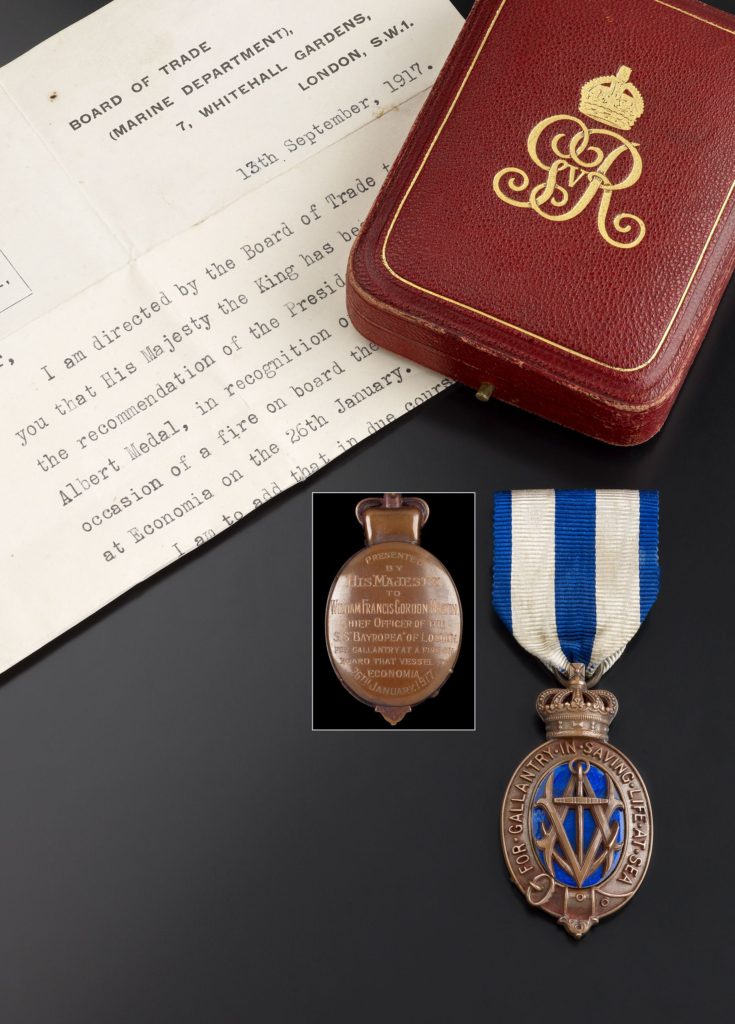Heroic acts of bravery are often commended in the issuing of a medal; in order to acknowledge and reward those who have gone above and beyond in the face of danger. Medals for saving life are either officially awarded by the government or by organisations and individuals.
The first official award by the British Government was the Sea Gallantry Medal in 1841, followed by the Albert Medal which Fellows have sold on two occasions in 2013 (Lot 352 & Lot 396). Both of these are 2nd Class bronze examples which were issued for gallantry at sea and land, denoted by the different coloured ribbons.
The custom of awarding medals for saving life stems from the work of organisations like the Royal Humane Society. Established in 1774, by doctors William Hawes (1736-1808) and Thomas Cogan (1736-1818), the society sought to highlight acts of bravery and attempts to resuscitate people who were otherwise deemed dead; in a bid to restore ‘a father to the fatherless, a husband to the widow, and a living child to the bosom of its mournful parents’[i].
Similarly, the Royal National Lifeboat Institution, or the RNLI as it is more commonly known, was established on the core principle of saving life at sea. Its founder Sir William Hillary believed that the shipwrecks he was witnessing from his home on the coast of the Isle of Man could be prevented and so decided to launch a service which provided ‘…immediate assistance… to persons rescued as their necessities may require[ii]’. In 1824, the RNLI awarded its first Gold Medal to Charles Fremantle for his valorous efforts to save the Carl Jean, a Swedish brig and its crew which had found itself in trouble off the coast of Christchurch.
These acts are often the consequence of a ‘freak’ event or natural disaster, resulting in the devastating loss of life. Fellows have also previously auctioned a Liverpool Shipwreck and Humane Society’s Marine Medal (Lot 359) in 2013; the society was formed following a hurricane which swept the Irish Sea in 1839. This example was named to the edge ‘To John Davies For Gallant Service. 5/8/28.’, and sold for three times its estimate achieving a hammer price of £320.
In our forthcoming Antiques, Silver & Collectables sale on Day two is Lot 852 – a Hamstead Colliery Disaster March 1908, 15 ct gold medal in original fitted case.
The Hamstead Colliery, near Birmingham, was subject to a disastrous fire on the 4th March 1908, causing 24 miners to become trapped underground. A chain of events leading up to the day, including some technical faults to the machinery, meant the attempts to rescue the miners did not go to plan and despite help from the volunteers of neighbouring Mine Rescue Brigades including Tankersley (Barnsley) and Altofts (Normanton), the Hamstead men were unable to save their colleagues from the perils of the fire.
A relief fund was raised following the disaster which was used to award 25 gold medals to the Hamstead miners who attempted to rescue their fellow workers before the arrival of the volunteer rescue parties, this included John Westwood, with whom Lot 852 is awarded. Westwood is recorded as being a miner at the colliery; his medal has remained in the family since the disaster in 1908.
On the 100th anniversary of the fire a permanent memorial was unveiled at the junction of Hamstead Road and the Old Walsall Road of an original coal tub on rails mounted on a brick plinth.
The memorial exists in conjunction with a display of mining memorabilia which has been gathered by the Hamstead Miners Memorial Trust at the Tanhouse Centre. In 1995, Birmingham Museum & Art Gallery acquired the Kesterton collection, which includes a postcard commemorating the Hamstead Colliery Disaster and a postcard of the miners final words, as seen below.
As with the memorial and postcards, John Westwood’s medal is a nod to the past and a reminder of the mining community which very much underpinned and supported the local economy and families of Birmingham, as such Lot 852 is sure to entice the bidders with its significant local interest.
If you would like more details of any of the lots in our Antiques, Silver & Collectables auction on Monday 7th August and Tuesday 8th August please view our online catalogues or contact us directly and we will be happy to help. The auction is available to view at our saleroom in Birmingham at the following times:
Saturday 29 July 2017 (selected items on view) 11am – 4pm
Thursday 3 August 2017 10am – 4pm
Friday 4 August 2017 10am – 4pm
Saturday 5 August 2017 11am – 4pm
Monday 7 August 2017 8.30am – 4pm
Tuesday 8 August 8.30am – 10.00 am
[i] http://www.royalhumanesociety.org.uk/html/history.html
[ii] https://rnli.org/about-us/our-history/timeline/1824-first-gold-medal-for-gallantry




